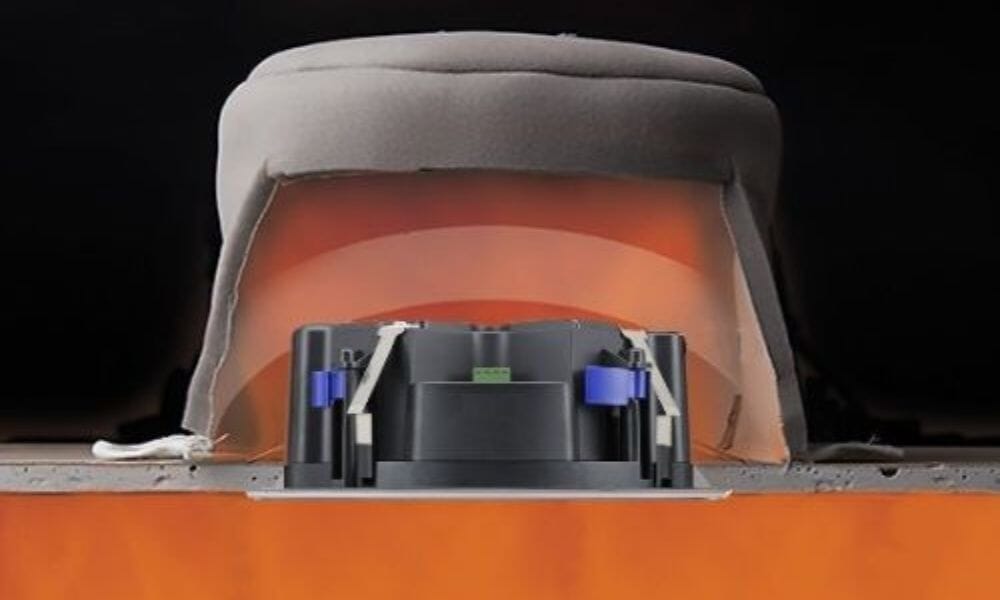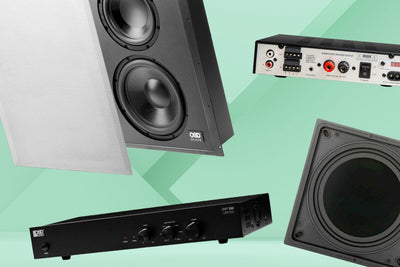Fire hoods probably aren't the first thing you think of when you're considering ceiling speakers for your home, but fire safety should be an important consideration for your home and family.
Any hole that's cut into your ceilings should be fire-rated or a fire hood installed.
For instance, your down lights should either be fire-rated as standard or an additional fire hood should be fitted over them. And speakers are no different.
This guide will help you to understand what they are, why & where you should add them and which ones are the safest and best value for money.
What Are Ceiling Speaker Fire Hoods?
Ceiling speaker fire hoods are made from intumescent fire-rated material and are fitted over in ceiling and in wall speakers with the purpose of maintaining the fire rating of your ceiling.
Their job is to:
- Maintain the fire integrity of your ceilings / walls.
- Comply with build control requirements.
- Comply with insurance requirements.
- Acoustic rated fire hoods will also reduce sound leakage above and may enhance sound quality within the room.
Don't worry, your speakers aren't going to catch fire.
Imagine that your kitchen caught fire, the plastic in-ceiling speakers are going to melt away very quickly allowing the fire to spread straight into the upstairs bedroom much quicker than it should do.
The ceiling speaker fire hoods maintain the 1 hour fire rating of your ceiling, reducing the time it takes for the fire to spread and thus increasing your chances of evacuating the house safely.
Why Do You Need Fire Hoods?
It's a common misconception that a ceiling speaker fire hood is there to protect the speaker.. however this isn't the case at all.
Let's say you are putting some speakers in your kitchen, and above it is your daughters bedroom...
Now touch wood this will never happen to you but if your kitchen caught fire your ceiling speaker will melt away in a matter of minutes leaving a big un-protected hole in the ceiling for the fire to spread through rapidly.
This is very easily resolved by installing a ceiling speaker fire hood with the ceiling speaker.
With a ceiling speaker fire hood fitted the integrity of the ceiling is protected, with some fire hoods rated at up to 90 minutes in compliance with BS EN1361-1.
Are Ceiling Speaker Fire Hoods Mandatory?
There's plenty of confusion about when and where in ceiling speakers will require a fire hood. Getting this wrong can be extremely costly.
The building safety regulations state that if you cut a hole in the fabric of your building then you should replace it with something of at least the same fire and acoustic rating as what you've removed.
Insurance companies are increasingly rejecting claims for fire damage on the basis that the building's fire integrity has been impaired by the installation of equipment into walls and ceilings, and in wall/ceiling speakers represent a serious breach to the integrity of the structure they are fitted to, in terms of fire, acoustics and heat loss.
The basic premise of the regulations state that it is the home owners, and installers responsibility to take measures to maintain these properties when installing equipment within the fabric of the building.
And therein lies the problem.
It can be argued that measures will always need to be taken no matter where in the building speakers are installed.
It is commonly accepted that wherever there is a habitable room above and the floor is made from timber / chip board etc then fire hoods are absolutely a requirement.
Frequently Asked Questions
Q. I'm installing speakers in a bedroom with only loft space above. Do I still need fire hoods?
A. There is some inconsistency between individual Building Control Officers on their interpretation of the regulations, but many are now insisting that all speakers are covered.
All the major developers we dealt with as installers (Redrow, Taylor Wimpey, Bellway etc) insist on them on all speakers.
The size of hole required for in ceiling speakers means that the ceiling's thermal, acoustic and fire rating is severely impaired and the thin paper cone of the speaker offers practically no remedy to the damage done.
If you are planning to install in ceiling speakers without hoods anywhere within a property, then permission should be sought from the relevant Building Control Officer.
If they agree to no hoods being fitted, we'd recommend you ask for this in writing and keep the document stored safely for future reference.
We'd also recommend you ask the home owner to sign a Disclaimer of Responsibility which makes it clear that the owner accepts responsibility, and understand that in the event of a fire, any insurance claim could be affected.
Q. I'm installing speakers in a pitched roof. Do I need to fit fire hoods?
A. As with the answer above, the installer has a responsibility to maintain the thermal properties of the structure.
With a pitched roof you will typically have to cut approximately 2 cubic foot of thermal insulation away to accommodate the speaker causing a serious breach to the thermal properties of the ceiling.
The thin cone of the speaker will do practically nothing to restore the ceilings thermal properties.
The Firetopper Pro has a high level of thermal insulation due to the air trapped in the acoustic foam layer, restoring most of the thermal insulation lost by cutting away the Kingspan or other insulating material.
We'd also recommend filling any remaining cavity cut away with Rockwool.
Q. I'm installing speakers in a suspended ceiling with a concrete floor above. Do I need to fit fire hoods?
The first thing you need to find out is wether the void between the ceiling and the concrete floor above is a Plenum Space.
Plenum spaces are the open spaces above the ceiling or below the floor that are used for air circulation.
If the void is a Plenum Space, then yes, fire hoods will be required. If not, you'll still need to consider the other factors so again if you are planning to install in ceiling speakers without a hood, written permission should be sought from the Building Control Officer, and disclaimers put in place.
Q. I'm installing in wall speakers in an internal stud wall? Do I need to fit fire hoods?
A. If the adjoining room forms part of a Fire Escape Route, then yes, fire hoods will be required.
If not, then again seek advice from your building control officer and make sure you have your disclaimer in place.
Q. I'm installing in wall speakers in an internal stud wall ? Do I need to fit fire hoods?
A. If the adjoining room forms part of a Fire Escape Route, then yes, fire hoods will be required.
If not, then again seek advice from your building control officer and make sure you have your disclaimer in place.
Q. I've heard the regulations only apply to new builds, is that true?
A. Absolutely not. The exact same regulations apply to new and existing homes.
Q. I'm using ceiling speaker enclosures, do I need fire hoods?
A. Potentially! Sound enclosures are designed purely to improve the sound quality and stop leakage to rooms above.
However that doesn't mean that they are except from requiring fire hoods.
Some sound enclosures are fire rated, some aren't.
So check with the brand of enclosure that you are looking at for clarification.
If not then they will still need a fire hood as well, but in this instance we'd recommend going for the cheaper non-acoustic fire hoods opposed to acoustic ones.
Top 5 Ceiling Speaker Fire Hoods
Here's a list of the top ceiling speaker fire hoods, including cheap ceiling speaker fire hoods (cheap, but fully compliant!) and ranging up to the top of the range acoustic fire hoods.
1. Lithe Audio 250 Ceiling Speaker Fire Hood

Pros:
- Cheapest Ceiling Speaker Fire Hood Available
- Easy To Install
- Metal Clips To Secure To Ceiling
Cons:
- No Acoustic Properties.
- Check Your Speaker Size As It Struggles With Some 8" Speakers
£29.99
2. Lithe Audio 270 Acoustic Ceiling Speaker Fire Hood

Pros:
- Fire & Acoustic Rated
- Easy & Quick To Install
- Well Priced
Cons:
- No Metal Clips - Requires Sealing To The Ceiling - Not Difficult, But Requires Sealant (Sold Separately)
£45
3. Fire Topper PRO Acoustic Ceiling Speaker Fire Hood

Pros:
- Fire & Acoustic Rated
- Easy & Quick To Install
- Well Priced
Cons:
- No Metal Clips - Requires Sealing To The Ceiling - Not Difficult, But Requires Sealant (Sold Separately)
£45
4. Hoody Speaker Hoods

Pros:
- Fire & Acoustic Rated For Safety & Reduction Of Sound Leakage
- Metal Clips To Secure To Ceiling
- Easy To Install
- Popular & Well Established Brand In The Fire Hood Market
- Range Of Sizes From 3" to 10"
- In - Wall / Square Speaker Fire Hoods Also Available
Cons:
- Not The Cheapest But Arguably Still High In Value For Money With The Additional Features/Options Available
From £45.99
5. Q Install Ceiling Speaker Fire Hoods

Pros:
- Fire & Acoustic Rated For Safety & Reduction Of Sound Leakage
- Metal Clips To Secure To Ceiling
- Easy To Install
- Perfect Match For The Q Install QI Range Of Ceiling Speakers
- Range Of Sizes From 6.5" to 8"
- In - Wall / Square Speaker Fire Hoods Also Available
Cons:
- Not The Cheapest
£48
Conclusion
Hopefully you now have a better understanding of what ceiling speaker fire hoods are and why you should have them protecting your home and family.
If you have any further questions about fire hoods and safety when installing ceiling speakers then please speak to one of our experts on 02393 190955 and we will be happy to advise further.
Credits
Video & Some Content From Neil Taylor from FireTopper - FireTopper Ceiling Speaker Fire Hoods
Input & Guidance From Rob Staveley of Hoody Speaker Hoods - Hoody Fire & Acoustic Ceiling Speaker Hoods





